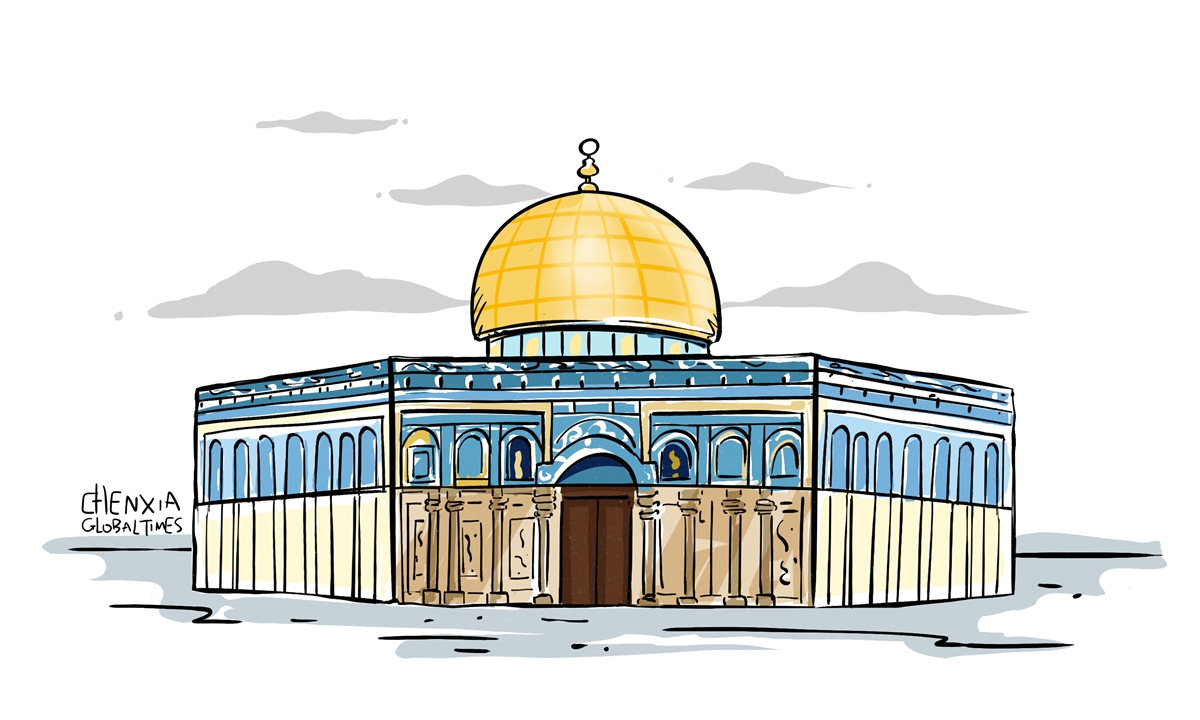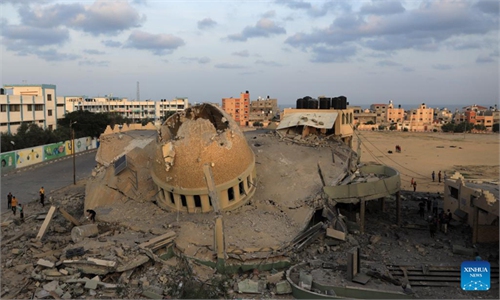ARTS / CULTURE & LEISURE
Escalation of conflict puts heritage at risk

Illustration: Chen Xia/Global Times
The recent escalation of the Israeli-Palestinian conflict has put cultural heritage there at risk. While there have been no reports of cultural heritage being damaged by the conflict thus far, the region is home to three major world religions and possesses numerous globally significant cultural heritage sites.In the Israeli-controlled areas alone, nine sites are listed as UNESCO World Heritage Sites, while four sites in the Palestinian-controlled areas hold the same designation. The preservation of these culturally invaluable heritage sites from the ravages of war requires heightened attention from the international community, along with swift action.
Historical and cultural heritage disputes have long been one of the many triggers of the conflict, despite its deeply complex roots.
In 2023, the UNESCO World Heritage Committee approved the inclusion of Ancient Jericho/Tell es-Sultan into the World Heritage List, following applications made by the Palestinian side.
However, Israel strongly opposed these listings. Israel has also opposed the acceptance of Palestine as a member state of UNESCO in 2011 and subsequently withdrew from the organization in 2019.
While the true reasons and timing for Hamas' large-scale attack on Israel have yet to be fully assessed, one reason publicly given by Hamas was a response to Israel's "desecration" of the Al-Aqsa Mosque.
The Al-Aqsa Mosque, located in Jerusalem's Old City, holds significance for both Islam and Judaism and has long been a focal point of the Israeli-Palestinian conflict.
Throughout this year, extremist right-wing factions within the Israeli government have been continuously taking provocative actions around this religious site.
Shortly before Hamas' action, a large number of far-right Israeli individuals had stormed the Al-Aqsa Mosque.
Consequently, Hamas named its military attacks on Israel "Operation Al-Aqsa Flood," clearly displaying revenge as a motive and seeking to mobilize religious and cultural sentiments among Muslims and Arabs to legitimize their actions.
Currently, the primary international treaty for protecting cultural heritage from destruction during armed conflict is the 1954 Convention for the Protection of Cultural Property in the Event of Armed Conflict, which can be shortened as the 1954 Hague Convention, along with its first and second protocols.
The 1954 Hague Convention requires signatory parties to take appropriate measures to safeguard and respect cultural heritage sites within their own territories and the territories of other contracting parties, preventing its destruction, looting, or loss during armed conflicts. However, the convention allows contracting states to "waive" these obligations under circumstances of "military necessity."
In other words, attacks on cultural heritage sites are considered legitimate and not a violation of the convention if there exists an urgent military need.
The lack of detailed provisions or limitations on how this military exception should be applied has resulted in its frequent abuse, limiting the practical enforceability of the convention.
To address this flaw, the second protocol to the convention introduced amendments specifically targeting this exception, requiring that cultural property must have become a military objective and that no feasible alternatives exist to gain the same military advantage before invoking hostile action against cultural property.
Palestine has ratified the 1954 Hague Convention and its two protocols, while Israel has ratified the 1954 Hague Convention and the First Protocol but has not yet ratified the Second Protocol. Therefore, theoretically, the 1954 Hague Convention and the First Protocol should apply to Israel and Palestine.
However, according to Article 18(1) of the 1954 Hague Convention, the convention only applies in situations of international armed conflict.
This means that the involvement of two or more countries is a prerequisite for the application of the convention.
As a result, there is considerable controversy over whether an armed conflict between one state and another non-state entity should be classified as "an international armed conflict."
This situation has created a legal vacuum and "lawless" territory regarding the protection of cultural heritage during armed conflicts in the Israeli-Palestinian context.
This worrisome condition should prompt urgent attention from the international community, as the safety of a significant amount of cultural heritage sites in the region cannot be guaranteed if international treaties are not respected and adhered to.
The outbreak of the Israeli-Palestinian conflict is the result of complex interactions between historical, cultural, religious, economic, and geopolitical factors, making it difficult to resolve quickly.
However, with the region's small geographic area and concentration of world-class cultural heritage sites that hold irreplaceable value in human civilization, any damage caused by the war would result in irreparable losses.
Therefore, the international community should unite and employ comprehensive diplomatic, political, and public means to urge the warring parties to take effective measures to protect cultural heritage, and when necessary, provide international assistance to ensure that the cultural heritage in this region is protected from the ravages of war, collectively safeguarding humanity's cultural heritage.
The author is a law professor at the China University of Political Science and Law. life@globaltimes.com.cn

